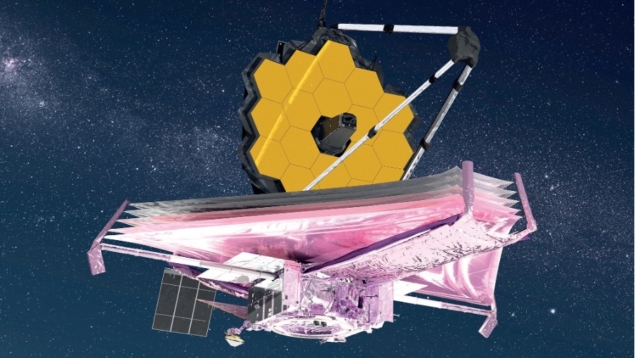
After 25 years of development, the James Webb Space Telescope (JWST) successfully launched from Europe’s spaceport in French Guiana on the morning of 25 December. Nerves were on edge as the Ariane 5 rocket blasted its $10 billion cargo through the atmosphere, aided by a velocity kick from its equatorial launch site. An equally nail-biting moment came 27 minutes later, when the telescope separated from the launch vehicle and deployed its solar array. In scenes reminiscent of those at CERN on 10 September 2008 when the first protons made their way around the LHC, the JWST command centre erupted in applause. “Go Webb, go!” cheered the ground team as the craft drifted into the darkness.
The result of an international partnership between NASA, ESA and the Canadian Space Agency, Webb took a similar time to design and build as the LHC and cost almost twice as much. Its science goals are also complementary to particle physics. The 6.2 tonne probe’s primary mirror – the largest ever flown in space, with a diameter of 6.5 m compared to 2.4 m for its predecessor, Hubble – will detect light, stretched to the infrared by the expansion of the universe, from the very first galaxies. In addition to shedding new light on the formation of galaxies and planets, Webb will deepen our understanding of dark matter and dark energy. “The promise of Webb is not what we know we will discover,” said NASA administrator Bill Nelson after the launch. “It’s what we don’t yet understand or can’t yet fathom about our universe. I can’t wait to see what it uncovers!”
The promise of Webb is not what we know we will discover. It’s what we don’t yet understand or can’t yet fathom about our universe
Bill Nelson
Five days after launch, Webb successfully unfurled and tensioned its 300 m2 sunshield. Although the craft’s final position at Earth–Sun Lagrange point 2 (L2) ensures that it is sheltered by Earth’s shadow, further protection from sunlight is necessary to keep its four science instruments operating at 34 K. The delicate deployment procedure involved 139 release mechanisms, 70 hinge assemblies, some 400 pulleys and 90 individual cables – each of which was a potential single-point failure. Just over one week later, on 7 and 8 January, the two wings of the primary mirror, which had to be folded in for launch, were opened, involving the final four of a total of 178 release mechanisms. The ground team then began the long procedure of aligning the telescope optics via 126 actuators on the backside of the primary mirror’s 18 hexagonal segments. On 24 January, having completed a 1.51 million-km journey, the observatory successfully inserted itself into its orbit at L2, marking the end of the complex deployment process and the beginning of commissioning activities. The process will take months, with Webb scheduled to return its first science images in the summer.

The 1998 discovery of the accelerating expansion of the universe, which implies that around 70% of the universe is made up of an unknown dark energy, stemmed from observations of distant type-Ia supernovae that appeared fainter than expected. While the primary evidence came from ground-based observations, Hubble helped confirm the existence of dark energy via optical and near-infrared observations of supernovae at earlier times. Uniquely, Webb will allow cosmologists to see even farther, from as early as 200 million years after the Big Bang, while also extending the observation and cross-calibration of other standard candles, such as Cepheid variables and red giants, beyond what is currently possible with Hubble. Operating in the infrared rather than optical regime also means less scattering of light from interstellar gas.
With these capabilities, the JWST should enable the local rate of expansion to be determined to a precision of 1%. This will bring important information to the current tension between the measured expansion rate at early and late times, as quantified by the Hubble constant, and possibly shed light on the nature of dark energy.
Launching Webb is a huge celebration of the international collaboration that made this mission possible
Josef Aschbacher
By measuring the motion and gravitational lensing of early objects, Webb will also survey the distribution of dark matter, and might even hint at what it’s made of. “In order to make progress in the identification of dark matter, we need observations that clearly discriminate among the tens of possible explanations that theorists have put forward in the past four decades,” explains Gianfranco Bertone, director of the European Consortium for Astroparticle Theory. “If dark matter is ‘warm’ for example – meaning that it is composed of particles moving at mildly relativistic speeds when first structures are assembled – we should be able to detect its imprint on the number density of small dark-matter halos probed by the JWST. Or, if dark matter is made of primordial black holes, as suggested in the early 1970s by Stephen Hawking, the JWST could detect the faint emission produced by the accretion of gas onto these objects in early epochs.”
On 11 February, Webb returned images of its first star in the form of 18 blurry white dots, the product of the unaligned primary-mirror segments all reflecting light from the same star back at the secondary mirror and into its near-infrared camera. Though underwhelming at first sight, this and similar images are crucial to allow operators to gradually align and focus the hexagonal mirror segments until 18 images become one. After that, Webb will start downlinking science data at a rate of about 60 GB per day.
“Launching Webb is a huge celebration of the international collaboration that made this next-generation mission possible,” said ESA director-general Josef Aschbacher. “We are close to receiving Webb’s new view of the universe and the exciting scientific discoveries that it will make.”





